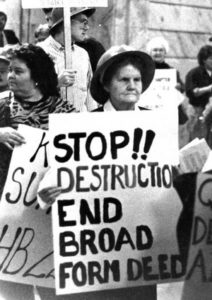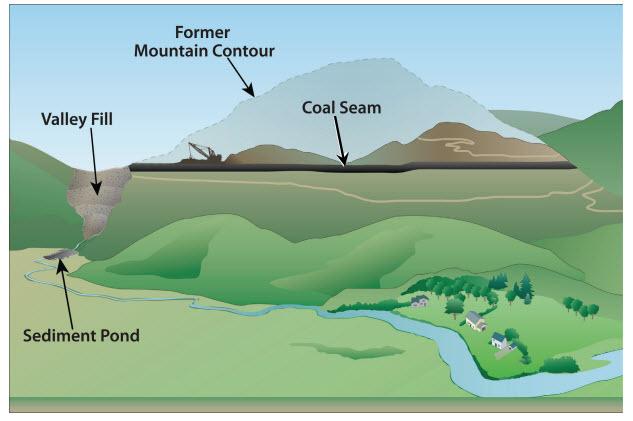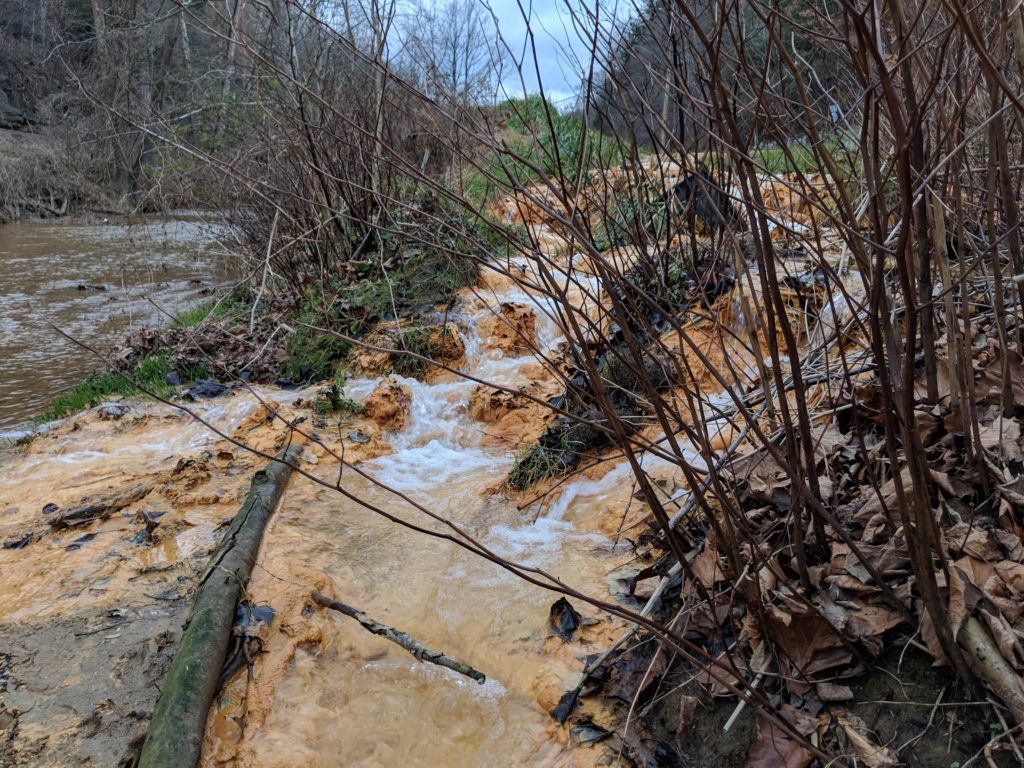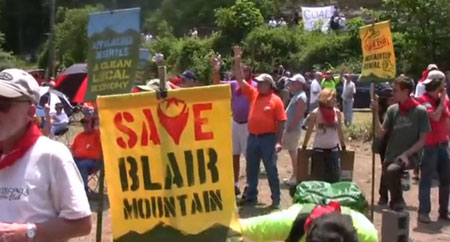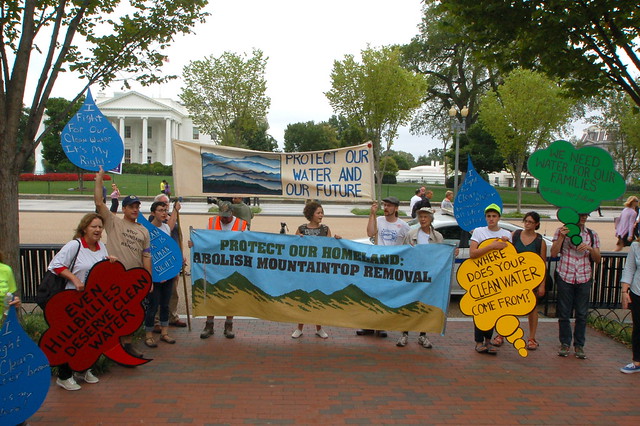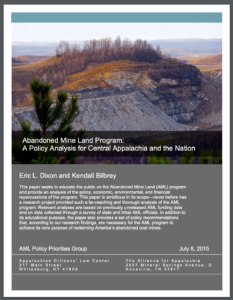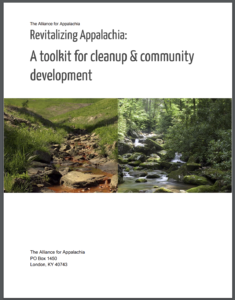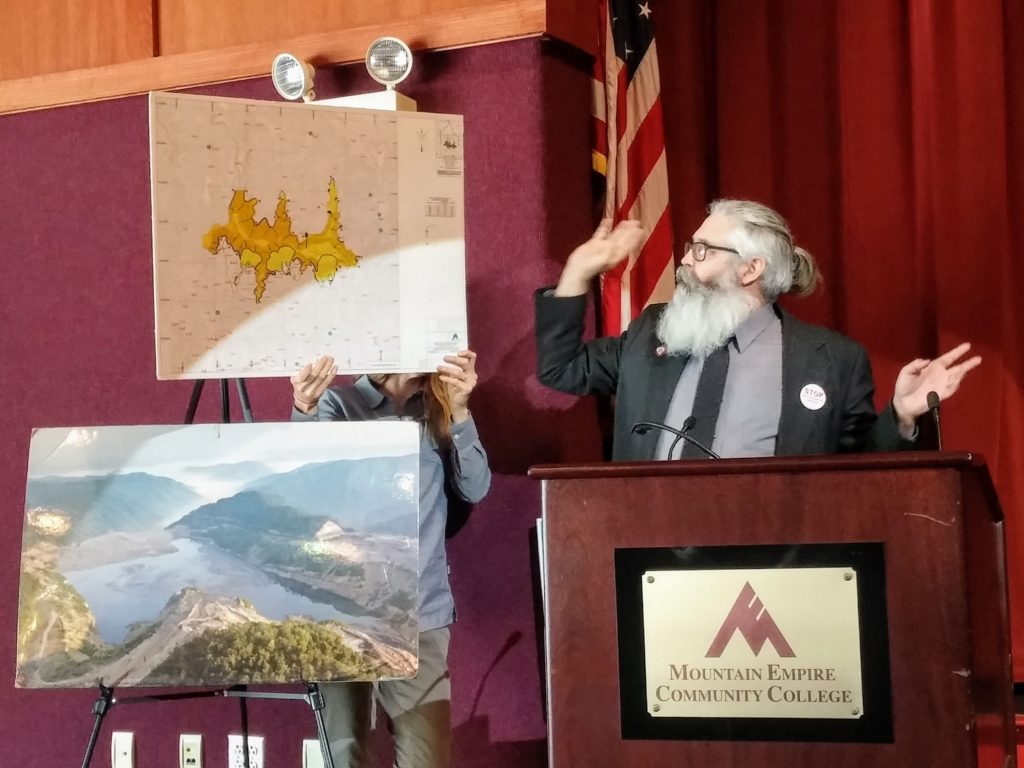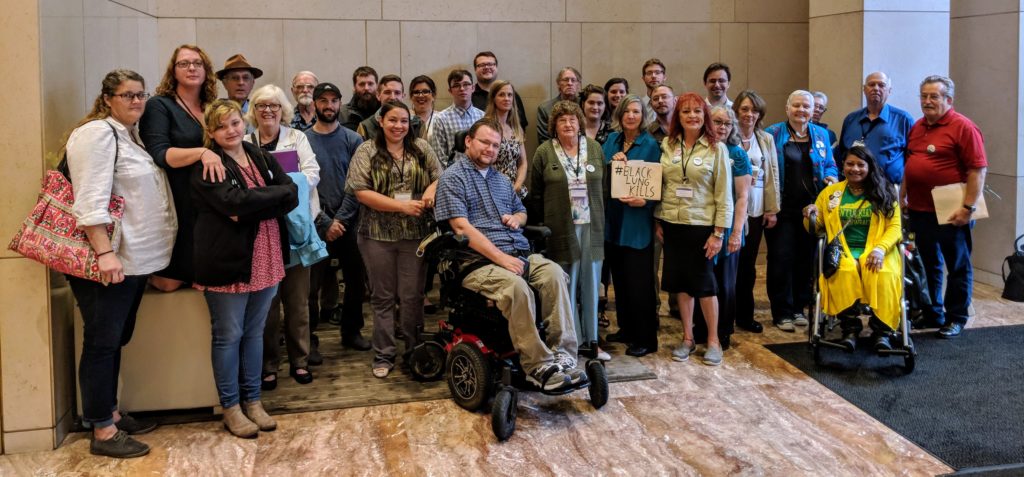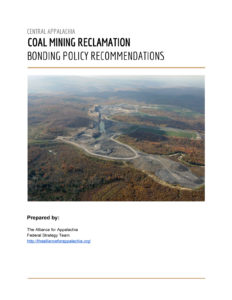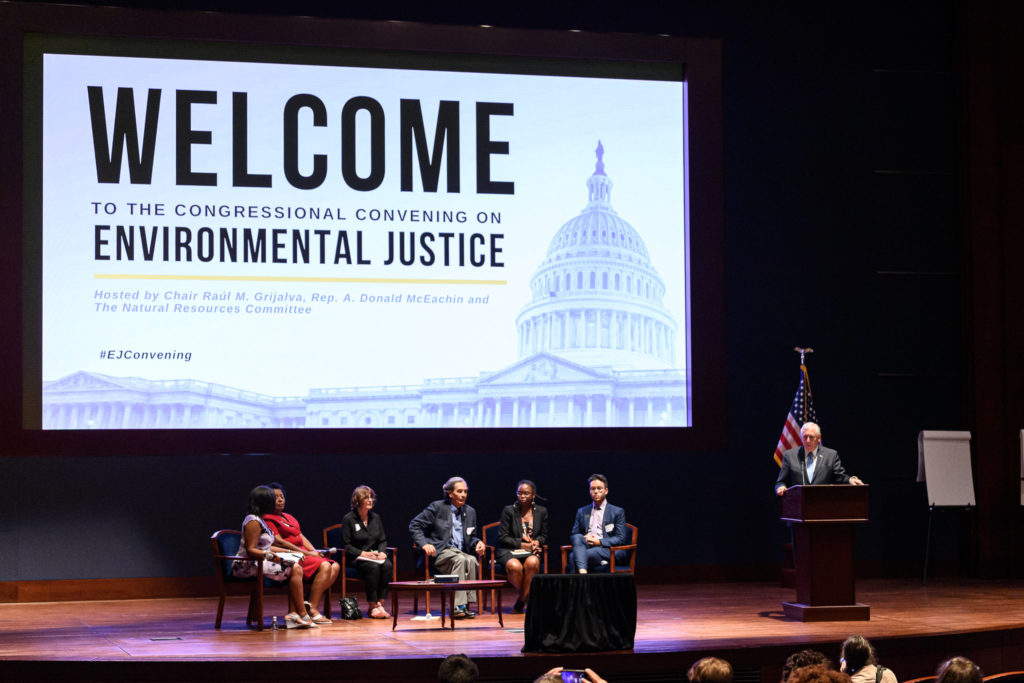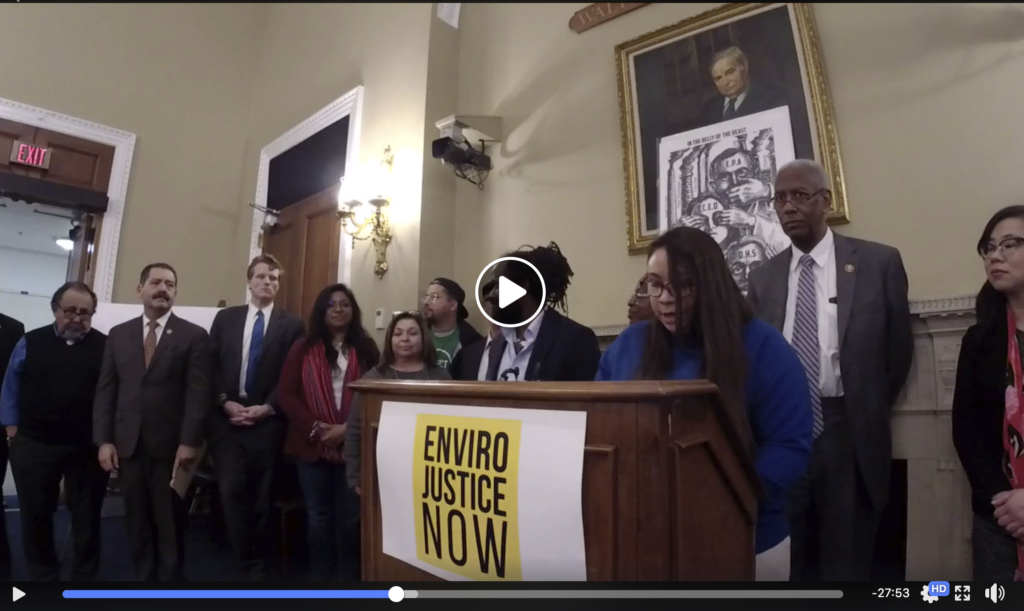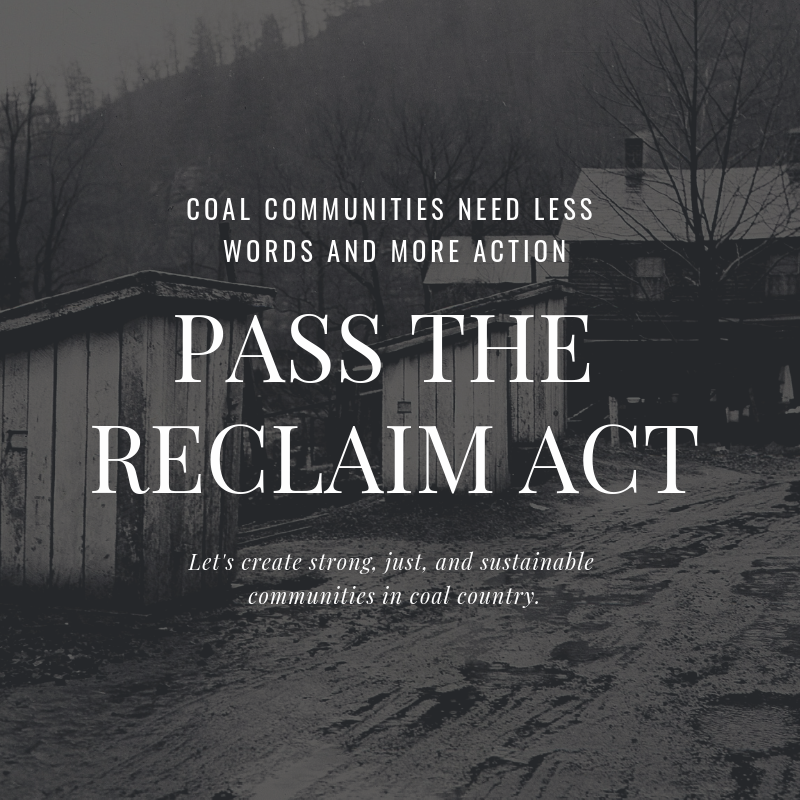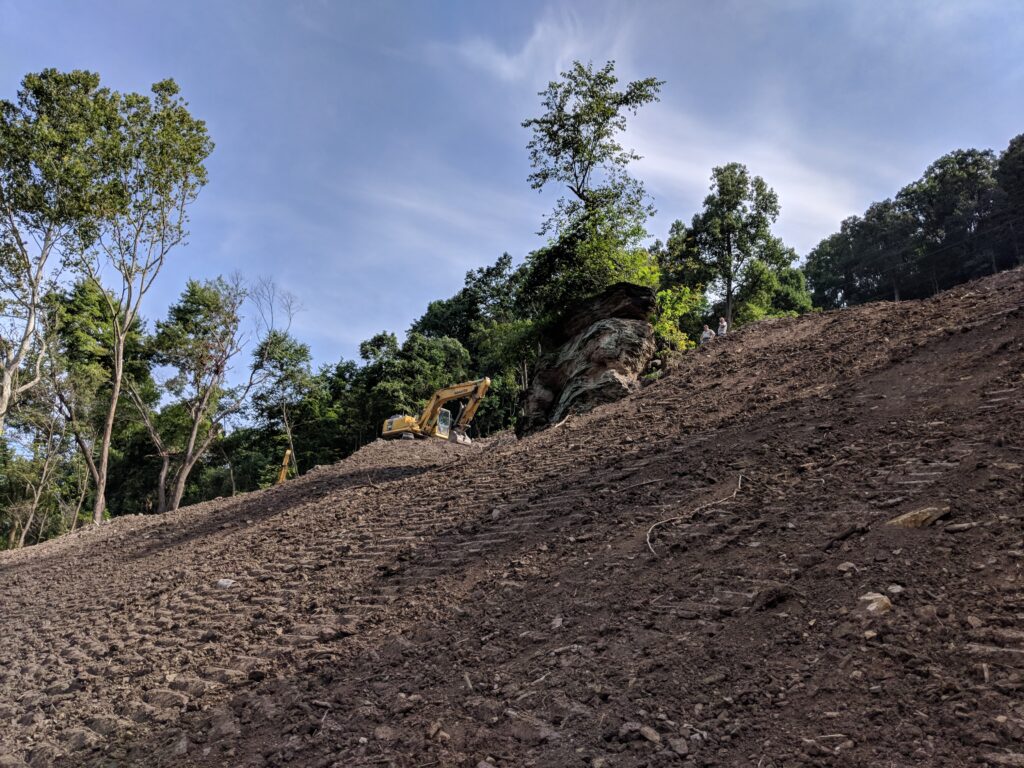Our History

Appalachian Coalition Against Strip Mining
The Appalachian region boasts a long, proud history of resistance by individuals, organizations, and alliances working to stop strip mining abuses in the region, beginning in the 1960s.
The Appalachian Coalition Against Strip Mining formalized some of these efforts in the 1970s by working with a national coalition of groups from coalfields across the country for federal legislation to ban the destructive practice. Groups fought against the inclusion of a mountaintop removal variance in the federal law and also worked for steep slope limits to mining and other protections for communities. Despite those efforts, the final bill that passed, the Surface Mining Regulation and Enforcement Act (SMCRA) of 1977, included a mountaintop removal variance and did not include other provisions like a steep slope limit.
The Alliance for Appalachia is founded
Beginning in the spring of 2006, thirteen organizations from five states in Central Appalachia worked together to build the Alliance for Appalachia, held the inaugural End Mountaintop Removal Week in D.C., and launched iLoveMountains.org
Clean Water Protection Act
The first years of our Alliance were spent building trust across organizations and across state lines with groups who brought different strategies, perspectives, relationships, and histories to the table. From 2007-2010 we took on a federal-level campaign to pass the Clean Water Protection Act which would ban the dumping of mining waste into our valleys and streams and significantly curtail mountaintop removal.
The Stream Buffer Zone Hearings
The Stream Buffer Zone rule had been in effect since 1983 to protect the nation’s headwater streams from being buried by valley fills from mountaintop removal coal mining, however, this rule was not stringently enforced, resulting in the loss of over 2,000 miles of headwater streams in the Appalachian region.
In October of 2007, the Office of Surface Mining-Reclamation and Enforcement (OSMRE) conducted public hearings on the then-proposed rule change. Kentucky, Pennsylvania, West Virginia, and Tennessee were granted these hearings. Virginia was not allowed a hearing even after numerous requests from local coalfield residents for a hearing.
Building Momentum
- Tens of thousands of letters to President Obama to prioritize an end to mountaintop removal.
- Organizing around Appalachia Restoration Act
- Organizing around the Clean Water Protection Act.
National Victory
- 2009 Appalachia Restoration Act is introduced in the U.S. Senate, and the first-ever Senate hearings on mountaintop removal are held.
- Documented more than 30,000 Clean Water Act violations at Kentucky coal mines, and brought legal actions against the companies that lead to unprecedented fines.
- Gained 172 co-sponsors for the Clean Water Protection Act in the House of Representatives and twelve co-sponsors in the Senate.
- The Obama Administration released the “Interagency Action Plan to Address Strip Mining in Central Appalachia,” a Memorandum of Understanding between the Environmental Protection Agency, Army Corps of Engineers, Department of Interior, and Council of Environmental Quality. The plan resulted in the suspension of 86 permit applications, 79 of which were held for further review.
- Started planning inclusion and anti-discrimination training
- Started mini lobby trips to Washington, DC
- Local work and training on citizens rights under SMCRA, a weekend in Wise, VA.
Appalachia Rising! Voices from the Mountains.
Voices from the Mountains and Appalachia Rising travel to DC. More than a 1000 Appalachians and concerned citizens gather in DC to call for an end to mountaintop removal strip mining and the beginning to serious investment in sustainable economic diversification in Appalachia. The weekend included two full days of strategizing workshops, learning, featured speaker panels and discussions, cultural events, and entertainment followed by 2,000 people taking action at the White House and the agencies that permit mountaintop removal: the Environmental Protection Agency, Department of Interior, and Army Corps of Engineers. We also paid a visit to the financiers of mountaintop removal at PNC Bank. 114 people were arrested while taking their stand in an act of non-violent civil disobedience at the White House.
EPA Final Guidance on MTR
2010 – 2011
“Represented by Earthjustice and the Appalachian Center for the Economy and the Environment, seven conservation and social justice groups— the Sierra Club, Coal River Mountain Watch, Ohio Valley Environmental Coalition, West Virginia Highlands Conservancy, Kentuckians For The Commonwealth, Southern Appalachian Mountain Stewards, and Statewide Organizing for Community eMpowerment—have intervened in a coal mining industry lawsuit to support EPA’s use of this guidance and its effort to follow the Clean Water Act, consider the latest science, and protect America’s waters from destruction.”
July 2011
The EPA released new guidelines on MTR -The new guidelines place limits on what and how much mining waste can be dumped into local streams and were designed to protect 95 percent of the aquatic life throughout central Appalachia.
Marching On
- 6th Annual End Mountaintop Removal Week Washington, D.C. April 4-6, 2011
- Summer of 2011 was the March on Blair Mountain. Organized by Appalachia Rising, the March had four demands: preserve Blair Mountain, abolish mountaintop removal, strengthen labor rights, and invest in sustainable job creation for all Appalachian communities. Blair Mountain is where 10,000 coal miners fought in 1921 against the coal operators and their supporters who were severely repressing them as the miners attempted to organize. Over the course of a week, hundreds of people marched from Marmet, WV to Blair Mountain where more than 1000 people gathered for a rally and march to the top of Blair.
- In November 2011, the Alliance hosted a Visioning Summit at the Benham School House Inn in Eastern Kentucky. Over 70 participants from roughly 18 Appalachian organizations (as well as unaffiliated individuals) joined us for this three-day event.
- Conductivity guidelines first draft.
7th Annual Week in Washington
The Alliance for Appalachia hosted the 7th annual end mountaintop removal Week in Washington on June 2-6, 2012 with nearly 150 citizens in attendance. The Week in Washington is an integral part of our work to connect resident to the halls of power in DC, and in 2012 we continued our campaign toward national legislation that would ban valley fills. This year’s event was a tremendous success, with nearly 150 meetings with House, Senate and Federal Agency representatives! This year individual participants tied together different tactics in a new way for our movement by engaging in a day of action at the end of the lobby week and people noticed. In addition, 4,300 people visited websites featuring the event and hundreds of people across the country called their Representatives to tell them to vote the right way on the Clean Water Protection Act!
Citizen Enforcement, Awareness, Summits
- Hosted a legislative summit
- July 2012 convened a Citizens enforcement summit
- September 2012 mini lobby trip
- Focus national awareness on mountaintop removal at the Democratic National Convention in Charlotte, N.C.
- Early Winter 2012 we hosted a Region-Wide Economic Transition Summit. Outcomes included host more meetings like this, Re-do the land ownership study from the 1980s, and host a communication/ messaging retreat.
8th Annual Week in Washington & Appalachia Rising Day
May 2013 people came together from around Central Appalachia and across the county to stand up for a clean, healthy environment and an end to mountaintop removal coal mining. The combined efforts of our 8th Annual Week in Washington and the Appalachia Rising Day of Action tied together multiple campaigns for a better future for Appalachia! Together we advanced our campaign for strong water quality protection through the EPA and our work for strong regulations to protect our streams through the OSM by hosting agency meetings to share testimonies from Central Appalachia. The Alliance also joined a legal petition demanding the EPA take action to protect water, and many of us attended the Appalachia Rising Day of Action at the EPA.
ACE, Organizing, Economic Transition
- In May 2013 we launched the Appalachian Citizens Enforcement (ACE) Project–a collaboration of citizen water tester from across the region, taking monitoring into their own hands. Member groups across Appalachia joined together for a regional Big Dip Day where citizens across the mountains of Tennessee, Virginia, West Virginia, and Kentucky took water quality samples of their local streams. Together we are increasing water quality data collection and increasing awareness of water quality issues in the region. More than this, citizens also mailed in test results to the US EPA, showing the need for a strong conductivity rule-making to keep our water safe.
- In the summer of 2013 The Alliance for Appalachia hosted an Organizing Training for new organizers, rooted in the century-old legacy of Appalachian Organizing–bringing together organizers of today, as well as those from the days of the Black Lung Movement and the Pittston Stike–to share support, stories and skills.
- Held an Economic transition tour across the region culminating in a gathering in December. There was such an overwhelming swell of enthusiasm for the Regional Economic Transition Summit that our 30-person meet up morphed into a conference of nearly 60 attendees.
AML Summit, People’s Climate March, Ison Rock
- People’s Climate March includes a strong contingent from across Appalachia. Mountain leaders joined 400,000 in New York City for the People’s Climate March. Those fighting mountaintop removal were among some of the frontline communities to lead this historic march for climate protection.
- In October, our Economic Transition Committee, in conjunction with our AppFellow Kendall Bilbrey and Eric Dixon, AppFellow with the Appalachian Citizens Law Center, hosted a summit for folks across Central Appalachia to discuss and learn about the Abandoned Mine Land (AML) Fund and other potential strategies for cleaning up some of the toxic legacy left behind by the coal industry. A diverse group of stakeholders, including impacted community members, non-profit organizations, scholars, policy experts, lobbyists and scientists gathered for a packed day at Breaks Interstate Park at the border of Virginia and Kentucky to discuss the looming issue of Abandoned Mine Lands.
- Celebrated with local groups the successful fight to stop the Ison Rock Ridge mountaintop removal mine in Virginia.
- Reached a historic settlement with Frasure Creek Mining over its years-long violations of water law in Kentucky.
- 4 Asks – Report Card – shifting targets
Our Water, Our Future
The Alliance for Appalachia hosted dozens of Appalachian community leaders in DC along with allies from across the country to fight for the Our Water, Our Future. Our organizing team assembled a great training that introduced emerging leaders to the policy recommendations that our Federal Strategy team has developed for the Obama Administration. These administrative changes include a Conductivity Rule and strong Selenium Standard from the US Environmental Protection Agency and a strong Stream Protection Rule and Mine Fill Rule from the Office of Surface Mining Reclamation Enforcement. We summarized the basic asks in a Report Card that graded the Obama Administration on their efforts to stop mountaintop removal, then printed out the report card to present to the CEQ following our big meeting. In addition to sitting down with agency officials, groups met with Congressional Representatives, worked with EQAT to demand that PNC bank to divest from mountaintop removal.
AML Fund Policy Research Partnership
Partnered with Highlander & ACLC to publish an extensive, community-based research and policy analysis of the Abandoned Mine Land Fund (AML Fund), which laid a strong foundation for our ongoing work around AML and legacy pollution. It developed into a policy-driven, community-led campaign in support of the RECLAIM Act, a bill that accelerates the clean up of AML sites by promoting economic development. Through this work, we have built new partnerships, broadened our base, and shifted the narrative around a just transition in our communities.
RECLAIM introduced
- Two DC lobbying trips – 10 Alliance members in Spring and 40 in Summer to advocate for the RECLAIM Act, several meetings with agencies on water quality standards and just transition for our region
- As part of the 2016 budget, the Obama White House created the POWER Plus plan a $10 billion initiative to assist communities struggling with the decline of the coal industry in growing and diversifying their economies.
- The RECLAIM Act was first introduced in Congress, in February 2016 by a bipartisan group of legislators. The RECLAIM Act would provide an immediate economic boost through the release of $1 billion to reclaim abandoned coal mines.
- Got on the democratic platform, calling to end MTR
- TN got regional support to pass the lands unsuitable for mining
- Relaunch the Regional Land Study
- Added 2 member groups – Blackwater Riverkeeper, Center for Coalfield Justice
February
- Nullification of the Stream Protection Rule after years of work the Obama administration.
- Partnered with the Catalyst Project to host training around intersectional issues of privilege and oppression into our work.
Released Revitalizing Appalachia Toolkit
Released Revitalizing Appalachia: a toolkit for cleanup and community development was released in the Fall. Our Economic Transition team promoted the toolkit at the Central Appalachia Brownfields Conference, in meetings with local officials, and in a workshop in East Tennessee with partners from the Clearfork Community Institute, Woodland Community Land Trust, the STAY Project, and Sierra Club. The workshop was inspired by Highlander’s economics and governance curriculum, and designed for local leaders to explore both the assets and needs of their communities.
Congressman Grijalva Visits
Worked with Earthjustice to coordinate a tour of a mountaintop removal site in KY and a reclaimed site in Southwest VA with Congressman Grijalva. This included a town hall-style meeting, where about 30 community members shared their experiences, concerns, and ideas for addressing coal’s toxic legacy. It was through this connection we were able to share our research and report on the state of bonding practices in Central Appalachia. This information was used as a resource to draft an upcoming energy bill through the House of Natural Resources.
September Lobby Trip
In September 2018, 36 Appalachian leaders from 6 states (AL, KY, PA, TN, VA, WV) joined the Alliance to lobby for Black Lung benefits, the RECLAIM Act, and miners’ pensions. We had 43 + visits with Senators and Representatives, identified a potential Senate author for the Black Lung extension bill, and laid the groundwork for co-sponsors in the House and Senate.
Coal Mine Bonding Report
In April 2018, we released our findings from a year-long research and analysis process that examined bonding practices across Central Appalachia. We issued the report to lend further evidence for the need to eliminate self-bonding and pool bonding of surface coal mines across the country. Our report was released a few weeks after the Government Accountability Office issued a report on bonding and urged Congress to amend the Surface Mining Control and Reclamation Act (SMCRA) to eliminate self-bonding.
Anne Braden Fellowship
Several of our members and a staff member participated in a Catalyst-led fellowship opportunity called the Braden Program, a 4-month long political education and leadership development program that is designed to support white activists in becoming accountable, principled anti-racist organizers to build multi-racial movements for justice.
Environmental Justice Convening in DC
The Alliance for Appalachia was one of many coalitions taking part in the House Committee of Natural Resources’ Environmental Justice Working Group. Several members took part in the Environmental Justice Convening on June 26, 2019.
Environmental Justice for All Act
Alliances from across the country, including the Alliance for Appalachia, participated in a year-long Environmental Justice Working Group with the House Committee on Natural Resources to establish guiding principles that would inform the Environmental Justice for All Act. Read more here.
RECLAIM Passes the House
In July the RECLAIM Act (H.R. 2156) passed the U.S. House of Representatives as part of The Moving Forward Act (H.R. 2), a bill to address America’s infrastructure needs and create jobs in the wake of the economic and health crisis caused by COVID-19. Read ACLC’s press release here.
Historic Investments in Abandoned Mine Land Reclamation
This legislation includes an unprecedented $11.3 billion in Abandoned Mine Land (AML) funding and also reauthorizes the Abandoned Mine Reclamation Fee for 13 years at 80% of its current level. The AML funding represents a massive increase compared to the current annual distribution for AML reclamation and restoration. It nearly doubles the amount to be distributed in just 15 years and would roughly equal the reclamation costs currently in the federal database. This is one of the largest investments in our communities in decades!

